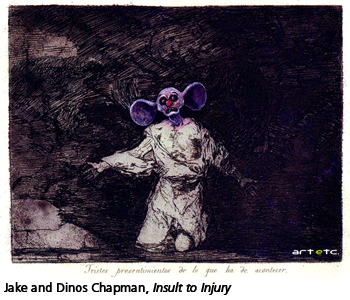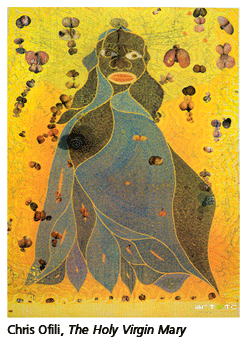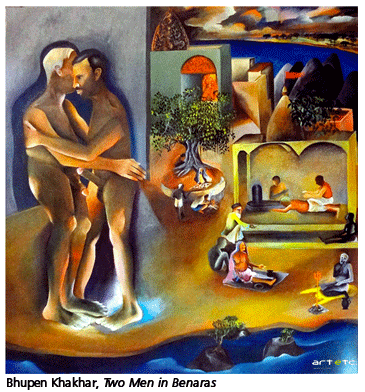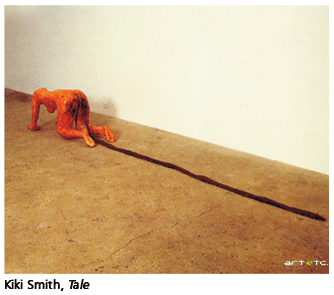- Publisher's Note
- Editorial
- Guerrilla Girls: The Masked Culture Jammers of the Art World
- Creating for Change: Creative Transformations in Willie Bester’s Art
- Radioactivists -The Mass Protest Through the Lens
- Broot Force
- Reza Aramesh: Action X, Denouncing!
- Revisiting Art Against Terrorism
- Outlining the Language of Dissent
- In the Summer of 1947
- Mapping the Conscience...
- 40s and Now: The Legacy of Protest in the Art of Bengal
- Two Poems
- The 'Best' Beast
- May 1968
- Transgressive Art as a Form of Protest
- Protest Art in China
- Provoke and Provoked: Ai Weiwei
- Personalities and Protest Art
- Occupy, Decolonize, Liberate, Unoccupy: Day 187
- Art Cries Out: The Website and Implications of Protest Art Across the World
- Reflections in the Magic Mirror: Andy Warhol and the American Dream
- Helmut Herzfeld: Photomontage Speaking the Language of Protests!
- When Protest Erupts into Imagery
- Ramkinkar Baij: An Indian Modernist from Bengal Revisited
- Searching and Finding Newer Frontiers
- Violence-Double Spread: From Private to the Public to the 'Life Systems'
- The Virasat-e-Khalsa: An Experiential Space
- Emile Gallé and Art Nouveau Glass
- Lekha Poddar: The Lady of the Arts
- CrossOver: Indo-Bangladesh Artists' Residency & Exhibition
- Interpreting Tagore
- Fu Baoshi Retrospective at The Metropolitan Museum of Art
- Random Strokes
- Sense and Sensibility
- Dragons Versus Snow Leopards
- What Happened and What's Forthcoming
- Art Events Kolkata, February – March 2012
- Mumbai Art Sighting
- Art Bengaluru
- Delhi Dias
- Musings from Chennai
- Preview, March, 2012 – April, 2012
- In the News, March 2012
- Cover
ART news & views
Transgressive Art as a Form of Protest
Issue No: 27 Month: 4 Year: 2012
by Vishal Tondon
When Aubrey Beardsley lay on his death bed at the young age of twenty five, he was absolutely mortified he would not achieve salvation. Delirious and mumbling, he lamented he had sinned against God and all that was holy. When death stared him in the face, he almost disowned the transgressive artworks that had made him a notorious figure and an artist to reckon with. His works irreverent and visceral were symbolic of the decadent aesthetic of his times. He had pushed the boundaries of God, Church and societal norms to the extreme. Why the doubt in the last moments of one's life? It is the final moment of reckoning that betrayed the faith Beardsley actually held. Why then, through his work, had he put his faith to the test?
Transgressive art treads the thin line between veneration and irreverence, love and hate, private and public, and the sacred and the profane. When a true artist transgresses social mores through his art, he is putting his own faith on the anvil. This is one of the true purposes of art.
Often, this kind of radical art is suppressed through physical violence, instances of which have been on the rise in our country. This is a manifestation of the recent inclusion of the semitic concept of blasphemy in an Indian civilization as accommodative as ours. We should, in this context, remember the conditions that led to the self-imposed exile of M F Husain in the final years of his life.
 Transgressive art has the capacity to put our values those we hold as a nation or as a culture to the test. It works by confounding our interpretation and our judgment. When the beliefs we hold so dear are challenged, we are vulnerable to being offended. Yet, art that offends our value judgment should be engaged with sincerely as it exposes us to the shaky ground on which our values are so often based. In 2007, the closing of the annual exhibition at MSU Baroda, as a response to the 'offensive' works of the student Chandramohan, and his subsequent arrest were a direct assault of the rights of freedom of expression. This event recalled an incident that happened almost twenty years earlier in America, when the artwork Piss Christ by the photographer Andres Serrano was met with vehement opposition including hate mails and death threats.
Transgressive art has the capacity to put our values those we hold as a nation or as a culture to the test. It works by confounding our interpretation and our judgment. When the beliefs we hold so dear are challenged, we are vulnerable to being offended. Yet, art that offends our value judgment should be engaged with sincerely as it exposes us to the shaky ground on which our values are so often based. In 2007, the closing of the annual exhibition at MSU Baroda, as a response to the 'offensive' works of the student Chandramohan, and his subsequent arrest were a direct assault of the rights of freedom of expression. This event recalled an incident that happened almost twenty years earlier in America, when the artwork Piss Christ by the photographer Andres Serrano was met with vehement opposition including hate mails and death threats.
Much radical art takes the liberty of transgressing the boundaries and protocols of certain societal categories like God, religion, sexuality, gender, body and finally art history itself.
It should be mentioned at the outset in this essay that for the purposes of our discussion, we shall limit ourselves to artworks be they Western or Indian that fall under the ambit of what we now call 'the modern sensibility', 'Modernity', 'Modernism' and the times that follows.
The work of Goya has been extremely important in the development of modern aesthetic sensibility. Goya's predilection for the dark and the mysterious and his cynical assessment of human nature culminated in the horrifying Saturn Devouring His Son (1819-23). The work depicted cannibalism, a taboo. An allegory of Spain destroying her own people, this masterpiece is also testimony to the absurdity of human nature. It is through the exposing of irrationality that Goya presented his Enlightenment values.
 Interestingly, almost two centuries later, British artists Jake and Dinos Chapman would make a series of works called Insult to Injury (2003). Shocking as it may sound these are Goya's original prints from his series The Disasters of War (1810-1820), now reworked. Goya's etchings depicting scenes of macabre violence are now altered by the addition of funny faces and comic characters. The Chapman brothers have pushed irreverence and transgression to the limits in a bid to expose a much debased human nature still at work since Goya's times. They have highlighted the contemporary relevance of Goya's prints. Of course, this reworked series has been seen variously as an evil and meaningless desecration by vandals, and as the ultimate homage to Goya's masterpiece, a fitting extension of his despair. In 2007, the journalist Johann Hari also accused the Chapman brothers of adopting an anti-Enlightenment stance.
Interestingly, almost two centuries later, British artists Jake and Dinos Chapman would make a series of works called Insult to Injury (2003). Shocking as it may sound these are Goya's original prints from his series The Disasters of War (1810-1820), now reworked. Goya's etchings depicting scenes of macabre violence are now altered by the addition of funny faces and comic characters. The Chapman brothers have pushed irreverence and transgression to the limits in a bid to expose a much debased human nature still at work since Goya's times. They have highlighted the contemporary relevance of Goya's prints. Of course, this reworked series has been seen variously as an evil and meaningless desecration by vandals, and as the ultimate homage to Goya's masterpiece, a fitting extension of his despair. In 2007, the journalist Johann Hari also accused the Chapman brothers of adopting an anti-Enlightenment stance.
A century ago, with Science and the humanities coming of age, one would have expected rationality to finally sink in. But major parts of the works that form the corpus of Modernism are again testimony of the opposite. Duchamp's iconoclastic gesture of the readymade would become the benchmark against which the capacity of all future art to transgress societal and artistic conventions is assessed. His readymade sculpture The Fountain (1917) has been variously described as Surrealist and Dadaist. Of course, the transgressive gesture was at the core of Surrealism as well as Dadaism. And The Fountain would change forever the attitude in which the transgressive art is made. Magritte made the impertinent gesture of confounding our perceptions with his painting This is Not a Pipe (1928-29) as easily as he made and sold in a terrifying gesture of impudence forgeries of Picassos, Braques, Chiricos and even banknotes. With Duchamp and Magritte, the transgressive gesture is unburdened of somberness and acquires an attitude of irreverence. This attitude, in its various avatars, exists in art since then.

Back home, on Indian shores, a major act of transgression against God and organized religion was committed in the work of Francis Newton Souza. His work is seditious and irreverent. In an existentialist twist, Souza derecognizes all religious and moral constraints to find in life a meaning of his own. His transgressive art is in keeping God alive so he can contradict Him again and again. Souza's seminal painting Death of the Pope (1962) put all assumptions about authority of Church in crisis. In the West, two seminal works, Piss Christ (1987) by Andres Serrano and The Holy Virgin Mary (1996) by Chris Ofili carried the transgressive art to a new dimension altogether. These works employed base materials human and animal waste in the making of religious icons. Of course, the works were met with resistance and censorship from the moral police.

Censorship came down once again as a blow in 2007 on Jehangir Jani's sculpture-installation George and the Dragon that was part of his seminal show Great Expectations put up at the Museum Gallery in Mumbai. This work had homoerotic undertones and showed the protagonists in the nude. Jani, who is not new to the making of transgressions through his art, was forced to remove the work from his show. He has consistently strove to question the boundaries of his identity complicated by the categories 'Indian', 'Muslim' and 'Gay.' In Nu's Boat (1998), he creates an ark, alternative to the one created by Noah. Only, this one is for a 'homosexual reject' who would have been misfit for Noah's project. Here, Jani is making a breach of the dictates of the Word.

Anita Dube has her own way of defying the word of God. In her performance Meat Words (2005), she inverts the authority of the scriptural statement “the Word made flesh.” Her transgressive art is to carve words out of meat slabs; now flesh makes words.
 Flouting of sanctions on the categories of gender and sexuality gained momentum since the 1970s' sexual liberation. For instance, the significant canvas Two Men in Benaras (1982) by Bhupen Khakhar shows two men standing in a naked embrace with their visible genital excitement transgressively encroaching upon the aura of a religious setting. Of course, in Khakhar's work contraventions are many layered, as illustrated by his other 'homosexual paintings' including Yayati (1987) and From the River Yamuna (1993). In these works, the lowbrow encroaches upon the highbrow, the profane encroaches upon the sacred and the private encroaches upon the public.
Flouting of sanctions on the categories of gender and sexuality gained momentum since the 1970s' sexual liberation. For instance, the significant canvas Two Men in Benaras (1982) by Bhupen Khakhar shows two men standing in a naked embrace with their visible genital excitement transgressively encroaching upon the aura of a religious setting. Of course, in Khakhar's work contraventions are many layered, as illustrated by his other 'homosexual paintings' including Yayati (1987) and From the River Yamuna (1993). In these works, the lowbrow encroaches upon the highbrow, the profane encroaches upon the sacred and the private encroaches upon the public.
Earlier, in the sexual sphere, the private encroached upon the public in a major way with the Great American Nudes series (started in 1962) of Tom Wesselmann. With his soft-porn glamorous nudes, he transgressed a societal moral injunction that relegated sex to the realm of the secretive.
One of the more important achievements of the gay erotic artist Tom of Finland is that sexually provocative material which had until then been strictly 'underground' moved close to the artistic mainstream. The “dirty drawings” of Tom of Finland, along with the photography of Robert Mapplethorpe brought, in the 1970's and 80's, into mainstream discourse what was generally dismissed as 'pornography.' In the work of these two artists, the protocols of the sexual act itself were transgressed; their explicit depiction of sadomasochism has become an intrinsic part of any discourse on the limits of consent within a sexual encounter.
The Indian artist Mithu Sen on her part, speaking from a feminist perspective, commits a major breach of societal protocol when she speaks of the pain and the pleasure of female sexuality and of the sexual act itself. Her bold depictions of the vagina dentate and menstruation in the series Drawing Room (2005) take potshots at men's irrational fear of female sexuality. Another feminist artist, Tracy Emin, through her confessional art like My Bed (1998) reveals intimate details from her life in order to begin a discourse on female sexuality. She shows us her unmade bed, the site of her sexual encounter, in all its embarrassing glory.
The disobedience also of sanctions on the body has been the project of numerous artistic interventions recently. Foucault has said that power relations have an immediate hold upon the body; they invest it, mark it, train it, torture it, force it to carry out tasks, to perform ceremonies, to emit signs. But artists have time and again attempted to reclaim the body for manifesting their own subjective experience. The reclaiming of the body from the public sphere also aimed towards an assertion of identity, whether for the purposes of sexuality, gender, or caste and class struggles.
The work of Francis Bacon intervened in the politics of the body and exposed the body for what it is; mere animal presence. That is why his images can be 'horrifying.' In his paintings, the Christ, in his Deposition from the cross, is depicted as a carcass that has an uncanny resemblance to bestial remains. In some of his other canvases, the figures are ambiguously entwined. Are these figures making love, or are they embroiled in a battle unto death? Clearly, Bacon is speaking here of love relations that are embattled; love and hate encroaching onto each other, transgressing each other's boundaries.
While the living body has been appropriated and inscribed by power and authority, the dead body is also subject to rituals and sanctions. Death is a taboo that draws societal sanctions. Ron Mueck's sculpture Dead Dad (1996-97) skirts these sanctions and engages us in a direct and honest confrontation with the physical remains of the deceased. It is a similar kind of confrontation with death that Gieve Patel dealt with in his paintings Crushed Head (1984), Battered Man in Landscape (1993) and Crows with Debris (1999).
 Much crudity, scatological humor, and violence filled Francois Rabelais' writing in the 16th century. Explicit and vulgar insults filled several chapters of his notorious book 'The Life of Gargantua and Pantagruel.' The censors of the Sorbonne deemed it obscene, and in a social climate of increasing religious oppression, it was dealt with suspicion and censorship. According to Rabelais, the philosophy of his giant Pantagruel is rooted in "a certain gaiety of mind pickled in the scorn of fortuitous things." Continence physical as well as sexual is an attribute that has in 'civilized' societies been expected from the body. But many artists have attempted to rescue the body from this expectation too. They have challenged the call for continence. Thus, the private became the public a few centuries ago in the 'scatological' books 'The Life of Gargantua and of Pantagruel' and later in the drawings of Aubrey Beardsley made in 1896 for a translation of Aristophane's Lysistrata. In these works, bodily functions including the ludicrous act of wind breaking became a political expression of irreverence and dissent. Many visual artists too have protested against the expectation of continence. More recently, the American artist Kiki Smith, contravening the expectations of the history of sculpture, shows women in the non-idealized situations of menstruating, urinating, lactating and defecating. Her sculpture Tale (1992) ushers in a kind of stark realism in its depiction of a woman defecating.
Much crudity, scatological humor, and violence filled Francois Rabelais' writing in the 16th century. Explicit and vulgar insults filled several chapters of his notorious book 'The Life of Gargantua and Pantagruel.' The censors of the Sorbonne deemed it obscene, and in a social climate of increasing religious oppression, it was dealt with suspicion and censorship. According to Rabelais, the philosophy of his giant Pantagruel is rooted in "a certain gaiety of mind pickled in the scorn of fortuitous things." Continence physical as well as sexual is an attribute that has in 'civilized' societies been expected from the body. But many artists have attempted to rescue the body from this expectation too. They have challenged the call for continence. Thus, the private became the public a few centuries ago in the 'scatological' books 'The Life of Gargantua and of Pantagruel' and later in the drawings of Aubrey Beardsley made in 1896 for a translation of Aristophane's Lysistrata. In these works, bodily functions including the ludicrous act of wind breaking became a political expression of irreverence and dissent. Many visual artists too have protested against the expectation of continence. More recently, the American artist Kiki Smith, contravening the expectations of the history of sculpture, shows women in the non-idealized situations of menstruating, urinating, lactating and defecating. Her sculpture Tale (1992) ushers in a kind of stark realism in its depiction of a woman defecating.
Understandably, artworks such as Piss Christ, Two Men in Benaras and Tale could outrage the moral sensibility of some viewers. Oscar Wilde, speaking for transgressive art, proposed that 'the critic should be able to recognize that the sphere of art and the sphere of ethics are absolutely distinct and separate.' Moreover, Kieran Cashell, author of the book Aftershock: The Ethics of Contemporary Transgressive Art (2009) adds that to simply apply ethical evaluation to art is to somehow 'erode the intrinsic significance of art and risk compromising the exclusivity of the aesthetic experience.' Transgressive art employs dedicated means to engage with and hold the attention of the viewer. Art works that supposedly aim to outrage or violate basic mores and sensibilities actually compel us to look at reality often shorn of all artifice.